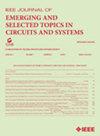无碰撞构建立方体(BBCube) 3D:使用WOW和COW的异构3D集成
IF 3.8
2区 工程技术
Q2 ENGINEERING, ELECTRICAL & ELECTRONIC
IEEE Journal on Emerging and Selected Topics in Circuits and Systems
Pub Date : 2025-07-22
DOI:10.1109/JETCAS.2025.3591677
引用次数: 0
摘要
我们提出了一种新的技术,称为无碰撞构建立方体(BBCubeTM) 3D用于人工智能和高性能计算(HPC)应用,需要高带宽和功率效率。BBCube 3D是通过异构3D集成构建的,其中xPU(例如CPU, GPU, TPU)芯片和DRAM芯片使用无凹凸的晶圆上(WoW)和晶圆上(CoW)工艺组合堆叠。无凹凸堆积工艺采用了类似于后端线(BEOL)多层金属化的方法,使BBCube能够在模具之间提供可靠和高密度的互连。此外,由于使用了薄硅和超薄的TSV结构,BBCube具有低电容和低阻抗的硅通孔(TSV)。为了进一步提高性能,引入了一种利用无颠簸WoW过程的高度并行DRAM架构。高密度tsv可以在不影响带宽的情况下实现更低的数据传输速度。此外,采用四相屏蔽I/O (FPS-I/O)可以降低电源电压。BBCube 3D有可能实现比DDR5高30倍、比HBM2E高4倍的带宽,同时实现比特访问能耗降低到DDR5的二十分之一、HBM2E的五分之一。BBCube中的低阻抗tsv可确保堆叠在分层DRAM之上的xPU具有强大的电源完整性。此外,在Cube上集成xPU可以实现高功率xPU的高效冷却。BBCube可以容纳功率密度超过50 W/cm2的xPU,与最新的gpu相当,同时保持DRAM温度低于95°C。本文章由计算机程序翻译,如有差异,请以英文原文为准。
Bumpless Build Cube (BBCube) 3D: Heterogeneous 3D Integration Using WOW and COW
We propose a novel technology called Bumpless Build Cube (BBCubeTM) 3D for AI and high-performance computing (HPC) applications that require high bandwidth and power efficiency. BBCube 3D is constructed through heterogeneous 3D integration, in which xPU (e.g., CPU, GPU, TPU) chiplets and DRAM dies are stacked using a combination of bumpless wafer-on-wafer (WoW) and chip-on-wafer (CoW) processes. The bumpless stacking process adopts a method similar to multilevel metallization in the back-end-of-line (BEOL), enabling BBCube to provide reliable and high-density interconnects between dies. Moreover, BBCube features low-capacitance and low-impedance through-silicon vias (TSVs) due to the use of thin silicon and slim TSV structures. To further enhance performance, a highly parallel DRAM architecture leveraging the bumpless WoW process is introduced. The high-density TSVs enable lower data transmission speeds without compromising bandwidth. Additionally, the adoption of four-phase shielded I/Os (FPS-I/O) allows for a reduction in power supply voltage. BBCube 3D has the potential to achieve a bandwidth 30 times higher than DDR5 and four times higher than HBM2E, while achieving bit access energy consumption reduced to one-twentieth that of DDR5 and one-fifth that of HBM2E. The low-impedance TSVs in BBCube ensure robust power integrity for the xPU stacked on top of the layered DRAM. Furthermore, integrating an xPU on top of the Cube enables efficient cooling of high-power xPUs. BBCube can accommodate an xPU with a power density exceeding 50 W/cm2 — comparable to the latest GPUs — while maintaining the DRAM temperature below 95°C.
求助全文
通过发布文献求助,成功后即可免费获取论文全文。
去求助
来源期刊

IEEE Journal on Emerging and Selected Topics in Circuits and Systems
ENGINEERING, ELECTRICAL & ELECTRONIC-
CiteScore
8.50
自引率
2.20%
发文量
86
期刊介绍:
The IEEE Journal on Emerging and Selected Topics in Circuits and Systems is published quarterly and solicits, with particular emphasis on emerging areas, special issues on topics that cover the entire scope of the IEEE Circuits and Systems (CAS) Society, namely the theory, analysis, design, tools, and implementation of circuits and systems, spanning their theoretical foundations, applications, and architectures for signal and information processing.
 求助内容:
求助内容: 应助结果提醒方式:
应助结果提醒方式:


